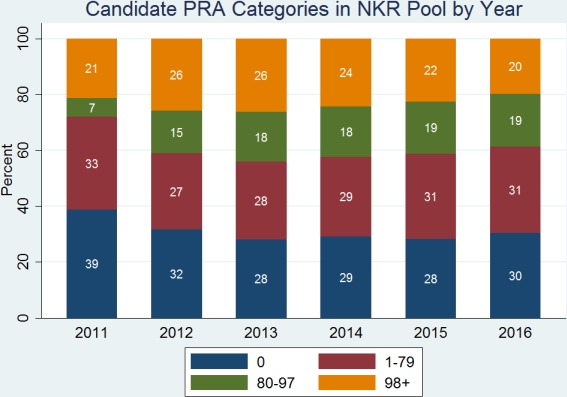Temporal Changes in the Characteristics and Sensitization of Kidney Paired Donation Registrants
1Johns Hopkins School of Medicine, Baltimore
2National Kidney Registry, New York
3David Geffen School of Medicine at UCLA, Los Angeles
4Terasaki Research Institute, Los Angeles
5Johns Hopkins School of Public Health, Baltimore.
Meeting: 2018 American Transplant Congress
Abstract number: 446
Keywords: Kidney transplantation, Sensitization
Session Information
Session Name: Concurrent Session: Kidney Paired Exchange
Session Type: Concurrent Session
Date: Tuesday, June 5, 2018
Session Time: 2:30pm-4:00pm
 Presentation Time: 2:42pm-2:54pm
Presentation Time: 2:42pm-2:54pm
Location: Room 4B
In order to utilize a willing but incompatible living donor, candidates must either proceed with incompatible transplantation or find a more compatible match using kidney paired donation (KPD). A criticism of KPD is that the "easy-to-match" candidates leave the registry quickly, and thus concentrate the pool with sensitized candidates, making future matches challenging.
Methods: We studied 2503 registrants to the National Kidney Registry (NKR), the largest KPD clearinghouse in the US, from 2011-2016. Both the incident and prevalent pool of candidates were studied over time.
Results: Candidates had a median age of 50 (IQR 39-60) years, were 51.2% male, 65.7% white, and had a median BMI of 27 (23-31). Overall, 58.5% had blood type O, 24.9% type A, 14.3% type B, and 2.2% had type AB. Overall, 29.6% had PRA 0, 29.8% 1-79, 17.7% 80-97, and 22.9% had PRA 98% or higher. There were no changes in the prevalent pool of candidates awaiting KPD (Figure 1), except an initial increase in candidates with PRA≥80% (28.0% in 2011 to 41.1% in 2012, Figure 2). Importantly there were also no changes in the rate of deceased donor kidney transplant over this time period.
Conclusion: In this large, national KPD clearinghouse, there is no evidence that candidates have become more “hard-to-match." Providers should continue to counsel candidates who are not sensitized and their potential donors to consider KPD.
Figure 1. Candidate Blood Type in NKR Pool by Year.
Figure 2. Candidate PRA Categories in NKR Pool by Year.
CITATION INFORMATION: Holscher C., Jackson K., Thomas A., Haugen C., DiBrito S., Ronin M., Waterman A., Massie A., Garonzik Wang J., Segev D. Temporal Changes in the Characteristics and Sensitization of Kidney Paired Donation Registrants Am J Transplant. 2017;17 (suppl 3).
To cite this abstract in AMA style:
Holscher C, Jackson K, Thomas A, Haugen C, DiBrito S, Ronin M, Waterman A, Massie A, Wang JGaronzik, Segev D. Temporal Changes in the Characteristics and Sensitization of Kidney Paired Donation Registrants [abstract]. https://atcmeetingabstracts.com/abstract/temporal-changes-in-the-characteristics-and-sensitization-of-kidney-paired-donation-registrants/. Accessed December 19, 2025.« Back to 2018 American Transplant Congress


